Example: A State-Space Controller for DC Motor Position
Control
Designing
the full-state feedback controller
Disturbance
Response
Adding
Integral Action
From the main problem, the dynamic equations in state-space form are the
following:
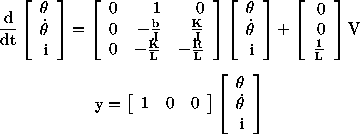
With a 1 rad reference added to the system, the design criteria are:
- Settling time less than 0.04 seconds
- Overshoot less than 16%
- Zero steady-state error to a step input
- Zero steady-state error to a step disturbance
Create a new m-file and
type in the following commands (refer to the main problem for the details of
getting those commands).
J=3.2284E-6;
b=3.5077E-6;
K=0.0274;
R=4;
L=2.75E-6;
A=[0 1 0
0 -b/J K/J
0 -K/L -R/L];
B=[0 ; 0 ; 1/L];
C=[1 0 0];
D=[0];
Designing the full-state feedback controller
Since all of the state variables in our problem are very easy to measure
(simply add an ammeter for current, a tachometer for speed, and a potentiometer
for position), we can design a full-state feedback controller for the system
without worrying about having to add an observer. The schematic for a full-state
feedback system is:
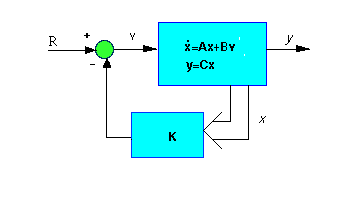
Recall
that the characteristic polynomial for this closed-loop system is the
determinant of (sI-(A-BKc)) where s is the Laplace variable. Since
the matrices A and B*Kc are both 3x3 matrices, there should be 3
poles for the system. By designing a full-state feedback controller, we can move
these three poles anywhere we want them. We shall first try to place them at
-100 + 100i and -100-100i (note that this corresponds to a zeta = 0.5 which
gives 0.16% overshoot and a sigma = 100 which leads to a .04 sec settling time).
Once we come up with the poles we want, Matlab will find the controller
matrix,Kc, for us. Simply add the following code to the end of your
m-file :
p1=-100+100i;
p2=-100-100i;
p3=-200;
Kc=place(A,B,[p1,p2,p3]);
Now look at the schematic above again. We see that after adding the K
matrix into the system, the state-space equations become:

We
can see the closed-loop response by simply adding the following line to the end
of your m-file:
t=0:0.001:.05;
step(A-B*Kc,B,C,D,1,t)
Run your m-file in the command window, You should see the following
plot:
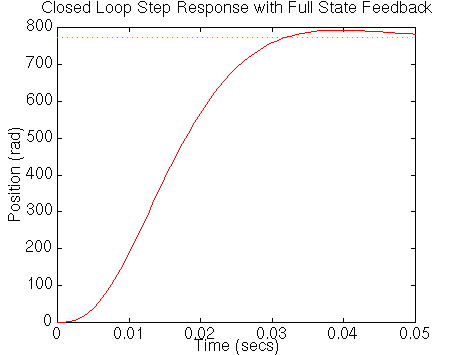
Disturbance Response
In order to get the disturbance response, we must
provide the proper input to the system. Physically, a disturbance is a torque
which acts on the inertia of the motor. A torque acts as an additive term in the
second state equation (which gets divided by J, as do all the other terms in
this equation). We can simulate this simply by modifying our closed loop input
matrix, B, to have a 1/J in the second row. Add the following line to your
m-file and re-run.
step(A-B*Kc,[0;1/J;0],C,D,1,t)
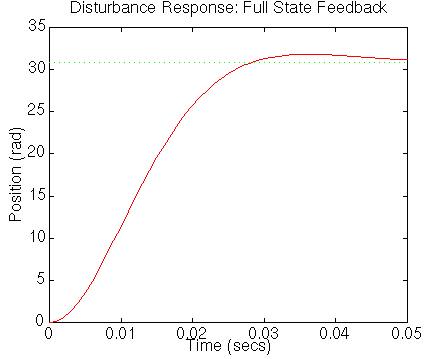
This
is not a zero steady-state error to a disturbance, and we will have to
compensate for this.
Adding Integral Action
We know that if we put an extra integrator in
series with the plant it can remove steady-state error to an input. If the
integrator comes before the injection of the disturbance, it will cancel the
disturbance in steady state. This changes our control structure so it now
resembles the following:
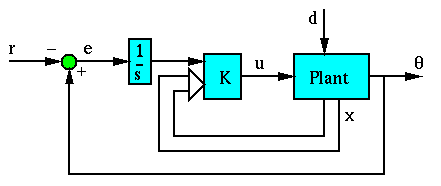
We
can model the integrator by augmenting our state equations with an extra state
which is the integral of the output. This adds an extra equation which states
that the derivative of the integral of theta is theta. This equation will be
placed at the top of our matrices. The input, r, now enters the system before
the integrator, so it appears in the newly added top equation. The output of the
system remains the same.
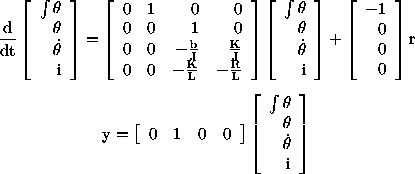
These
equations represent the dynamics of the system before the loop is closed. We
will refer to the matrices in this equation as Aa, Ba,
Ca, and Da. We will refer to the state vector of the
augmented system as xa. Note that the reference, r, does not affect
the states (except the integrator state) or the output of the plant - this is
expected, since there is no path from the reference to the plant input, u,
without implementing the feedback matrix, Kc.
In order to find the closed loop equations, we have to look at how the input,
u, affects the plant. In this case, it is exactly the same as in the unaugmented
equations. Therefore, there is a vector, call it Bau, which replaces
Ba when we are treating u as the input. This is just our old B vector
with an extra zero added as a first row. Since u=Kc*xa is the input
to the plant for the closed loop, but r is the input to the closed loop system,
the closed loop equations will depend on both Bau and Ba.
The closed loop equations will become:

Now,
the integral of the output will be fed back, and will be used by the controller
to remove steady state error to a disturbance. We can now redesign our
controller. Since we need to place one closed-loop pole for each pole in the
plant, we will place another pole at -300, which will be faster than the rest of
the poles. Since the closed-loop system matrix depends on Bau, we
will use Bau in the place command rather that Ba. Add the
following to your m-file:
Aa=[0 1 0 0
0 0 1 0
0 0 -b/J K/J
0 0 -K/L -R/L];
Ba=[ -1 ; 0 ; 0 ; 0];
Bau=[0 ; 0 ; 0 ; 1/L ];
Ca=[0 1 0 0];
Da=[0];
p4=-300;
Kc=place(Aa,Bau,[p1,p2,p3,p4]);
t=0:0.001:.05;
step(Aa-Bau*Kc,Ba,Ca,Da,1,t)
Run your m-file (or just these new lines) and you will get the
following output.
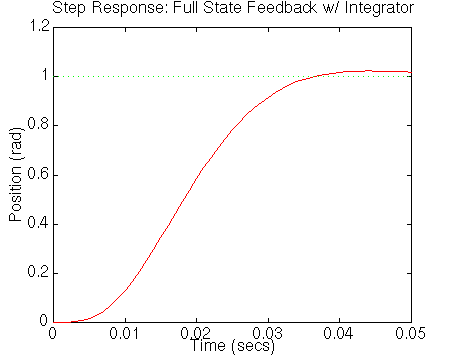
To
look at the disturbance response, we apply a similar B matrix as we did
previously when simulating the disturbance response.
step(Aa-Bau*Kc,[0 ; 0 ; 1/J ; 0] ,Ca,Da,1,t)
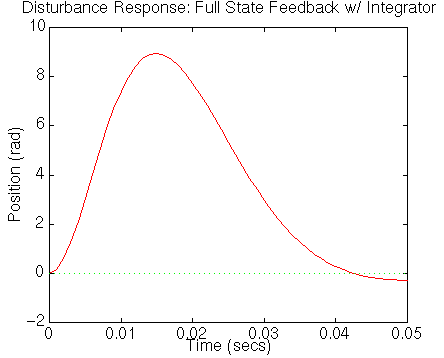
We can see that all of the design specifications have been met by this
controller.
[ Table des matières ]










